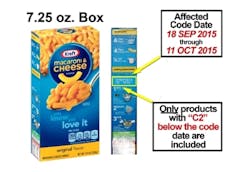No person wants to find metal in their macaroni and cheese. And no manufacturer wants to experience that quality control failure. But earlier this month, Kraft Foods Group had to deal with just this scenario as a result of multiple customer complaints. What followed was a swift recall of about 242,000 cases of the 7.25 oz. boxes of Kraft’s original flavor mac and cheese boxed dinner.
Having a sophisticated traceability system enabled the consumer packaged food and beverage giant to narrow down the affected products to a specific production line and “best when used by” dates. No injuries were reported, and, by proactively initiating a voluntary recall and publically apologizing, the company keeps its brand reputation intact.
But the question remains (in my mind, anyway): How the heck did metal get into the mac and cheese?
According to the U.S. Food and Drug Administration (FDA), metal-to-metal contact (e.g., mechanical cutting or blending operations and can openers) and equipment with metal parts that can break loose (e.g., moving wire mesh belts, injection needles, screens and portion control equipment, and metal ties) are likely sources of metal that may enter food during processing. And, a metal mix up does occasionally happen on the production line. In January, Unibright Foods recalled about 48,000 pounds of frozen sukiyaki beef and gingered pork products that may have been contaminated with metal materials. Last October, Sam Kane Beef Processors recalled over 90,000 pounds of ground beef products after four consumer complaints, including one person who reportedly chipped a tooth on a small piece of metal in the meat.
Here’s the thing, even with increasing regulatory and consumer demands, finding metal fragments—or any foreign material for that matter-- in food is just not acceptable. Therefore, it may be time to reexamine the quality control methods on the processing line. To that end, I’ve recently been hearing more about the use of X-ray inspection systems in the food processing industry.
Currently, many manufacturers depend on metal detectors at the end of the production line specifically for metal quality control. But these systems can’t identify other things, such as glass, bones, stones, and even stainless steel. X-ray machines, on the other hand, can.
Using X-ray for food inspection is not a new phenomenon, but it’s not been the preferred system for a few reasons, specifically the cost and the complexity of the machine. The X-ray suppliers have been doing what they can to lower the cost of the systems, but manufacturers still shy away from a piece of equipment that requires a highly-trained specialist to run and maintain it.
But that mentality may soon be changing. I recently spoke with David DiPrato, President and CEO of Novus X-Ray who claims the company has solved this problem with the addition of one-button auto-learning and plug-and-play replacement modules to speed repairs.
DiPrato believes the barrier to adoption is a direct result of the complexity issue, which is why the company developed its Critical Control Point with X-ray (CCPX) technology.
Traditionally, setting up an X-ray machine can be difficult as they require advanced image processing software to determine if a foreign object is present in the food or its packaging. Novus has introduced automatic training algorithms which allows a technician to visually inspect an image that has been falsely detected, and with one button, tell the machine to ignore similar detections in the future. No further adjustments, or even knowledge of how the image processing system works is required.
The other issue is maintenance.
“The biggest problem is failure rate,” says DiPrato, explaining that technicians on the plant floor don’t want to deal with such a complex machine if it goes down. However, Novus machines have just five components for processing detection, HMI, input-output electronics, X-ray generator, and cooling systems. Each module can be unplugged and a replacement module inserted with any recalibration or setting recovery taking place without worker intervention, making maintenance a matter of plug-and-play. “It’s a robust connection system so someone can’t put a cable in the wrong way. The machine can be back up and running quickly,” DiPrato says.
Despite the new easy-of-use capabilities, manufacturers may have additional concerns about the radiation from X-ray inspection systems and its impact on the food passing through it, as well as the health of the operators working in close proximity to the machine. Some vendors have said that the radiation levels from these machines are so low that food remains safe and loses none of its nutritional value. Similarly, they say, the average human is exposed to more natural background radiation in a year than what they would be exposed to from an X-ray system in the plant.
I’m sure any manufacturer would do some extra due diligence on the health-related aspects here. One thing is clear, food processing companies will need to upgrade quality control in order to comply with new regulations, keep customers safe, and protect their brands. X-ray is an option.
About the Author
Stephanie Neil
Editor-in-Chief, OEM Magazine

Leaders relevant to this article:
